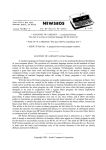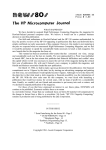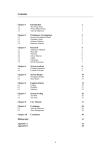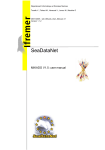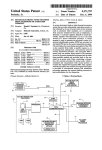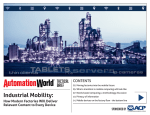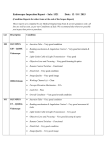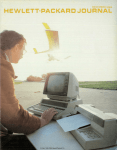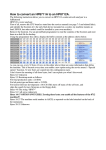Download IN THIS ISSUE... * The HP-85 Advanced Programming ROM * 400
Transcript
IN THIS ISSUE... * The HP-85 Advanced Programming ROM * 400 Billion Errors of Division * Series 80 Country - We Visit HP in Corvallis * Feedback ____________ FOUR TO SIX What looks like betting odds could turn into a sure thing for owners of HP Series 80 microcomputers. NEWS80S, the independent newsletter for owners of Hewlett-Packard Series 80 computers has announced that in 1983 its publishing schedule has been increased from four issues per year to six issues. “This will allow us to significantly increase our ability to provide timely and comprehensive coverage of Series 80 topics,” stated Dale Flanagan, Editor of the publication. “We plan on maintaining our coverage of HP-83 and HP-85 computers, and using the extra editorial space to expand our HP-86 and IIP-87 coverage. We will pay special attention to software reviews, Series 80 assembly language and HP Basic programming techniques. Past articles on these three topics have generated the most reader response for us. We’ll also continue to publish complete program listings for useful utility and application programs,” Flanagan added. NEWS80S started publishing in February of 1982. In May of 1982 the publication was sold to Joseki Computer Corporation, publishers of Apple, IBM and LIP personal computer software. The publication now covers approximately 10% of the known Series 80 owners in the U.S. Subscriptions to the publication are $15 for six issues ($30 for foreign subscribers). “Our per-issue price remains the same,” commented Flanagan, “but we are now supplying more issues per year.” Through its publisher, Joseki Computer Corporation, NEWS80S also sells low cost software to the Series 80 community. For 1983, NEWS80S plans to greatly increase this software line. The new publication schedule starts with the publication’s issue number 5, which will be in subscriber’s hands in April. Subsequent issues will appear every other month. Copyright 1983 - Joseki Computer Corporation PAGE 2 NEWS80S - Issue Number 5 HP ADVANCED PROGRAMMING ROM FOR THE HP-85 by Dale Flanagan HP’s standard Basic on the HP-85 is quite powerful, and since it did almost everything I wanted it to, I avoided paying the extra money for the Advanced Programming (AP) ROM. That was a mistake. If you do your own programming, the AP ROM is the most powerful enhancement you can buy for your HP-83/85 for under $200. It provides a variety of extensions to HP Basic which will make your programming efforts more efficient and enjoyable. It will also greatly increase your ability to control the screen display and operations of most programs. Probably the most powerful extension is a series of commands which allow you to create and use Basic subprograms. Subprograms are separate Basic programs which can reside in memory along with your main Basic program. Subprograms may be called into memory from the mass storage device, and they may be eliminated from memory selectively or as a group to make room for other subprograms. Parameters can be passed to subprograms by variable address or by value. Passing parameters by address will return any altered values to the main pro- gram. It should be noted that the actual variable names used in the subprogram do not have to be the same names used in the main program. For instance, a main program can “call” a subprogram, passing addresses for “X” and “Y” . The sub- program, however, could use variable names “A9” and “C7” (for instance) instead of X and Y. By passing variable addresses, the subprogram changes to A9. and C7 would by assigned to X and Y in the main program. This means that you have complete freedom to call your variables anything you wish in the main program, without worrying what they were called in the subprogram. An equally powerful feature is the ability to pass parameters by value. In this case the subprogram can perform its functions without affecting the values of variables in the main program. In other words, a subprogram can also have “local variables” which won’t interact or affect the variables in the main program. The ability to call subprograms from mass storage and the use of global (parameter passing by variable address) and local variables is a tremendous enhancement that resembles the “procedures” found in advanced computer languages like Pascal. It means that common program functions such as data editing, file handling, or similar routines need to only be written once. After they are written, you may use them in countless other “main” programs, greatly expanding your ability to write programs quickly and efficiently. You may build a library of common routines, and “call” them from main programs only as needed. At the end of this article you’ll find an example of two useful subprograms to handle data files. It should be noted that the numbering of various sub- programs may repeat the line numbers found in the main program or other subprograms, and that multiple subprograms can reside with a single main program in memory. The new commands that allow the creation, use and maintenance of subprograms would, in my opinion, justify the purchase of the AP ROM, but there’s considerably more. The AP RUM also provides several new features and Basic statements which make programming easier. There’s a whole slew of statements that allow you to manipulate the internal HP-83/85 clock (reading time or timers, converting to Julian date, converting hours and minutes to seconds, etc.). There’s a way to merge programs together, renumbering the merged program as you do so. There’s a very useful way to list all variables or referenced line numbers, and the line numbers where the variable is used or where the line is referenced. There’s also a large number of string functions. Many of these functions seem to have a limited useful application (i.e. one reverses the NEWS80S - Issue Number 5 PAGE 3 order of characters in a string, another wraps the string around on itself, shifting letters to the right or left), but others allow you to highlight a string or trim leading and trailing blanks from a string. To the joy of programmers use to them, the AP ROM provides five commands to define and use string arrays in HP Basic. These are only one dimensional arrays, but they provide a convenient way to manipulate string data when used in combination with the other HP string functions. Most programs use variables as flags, indicating an off/on or yes/no state. With the AP ROM you can have 64 flags and use up only 8 bytes of memory. A special flag command allows you to set and read these one bit flags individually, and you can even manipulate, transfer or save all the flags as an 8 character string, using additional commands. The ROM also provides enhanced error handling information, giving you the ROM number where the error was detected. There are also many commands involving the entry and display of data with the HP-83/85. My favorite is LINPUT, which allows the input of strings with commas and other “illegal” punctuation not accepted by a normal INPUT statement. The AP ROM also provides comprehensive cursor and text screen control, allowing the programmer to create more sophisticated data entry and information display-screens. Following this article is a short demonstration program that illustrates some of this control. The AP ROM also provides a way to “take over” the entire keyboard of the HP-83/85, making all keys function like the soft keys (i.e. keys K1-K8). A short demonstration program is provided on this capability, also. The AP ROM provides approximately 50 new Basic commands, so there are other new commands we’re sure we haven’t uncovered or had a chance to use yet. Despite this, the features we have used have left us suitably impressed. If you do your own programming, the AP ROM is an essential addition to your HP-83 or HP-85. An AP for the HP-87 was announced for release in December of 1982, but latest word from HP is that it will be April before the HP-86/87 AP ROM starts to hit stores. If it provides capabilities similar to the 83/85 AP ROM, this new ROM will be an exciting addition to the 86/87 line. ---------------FILE CREATION SUBPROGRAMS by Bruce A. Wagner The following are two subprograms I use for creating and/or assigning data - files. They’re designed to be CALLed by a program using the HP-85 Advanced Programming ROM, but they both can easily be converted to regular program subroutines, using the following procedure: 1. Delete line 10 in both NEWFL and OLDFL. 2. Replace SUBEND and SUBEXIT with RETURN in lines 110 and 240 of NEWFL, and 80 and 150 of OLDFL. 3. Delete line 220 of NEWFL and line 130 of OLDFL if the AP ROM is not available. 4. Before calling either subroutine, set B$=”buffer number” so the appro- priate buffer is assigned. 5. The file name will be returned in the string variable F$. SUB NEWFL (B, F$) : This subprogram will assign buffer number B to the file named F$. It is used to create a new file and also to open an already existing data file for data storage. If the user tries to create a new file with the same name as an already existing file, the program warns the user, allowing him or her to purge the existing file and create a new file with the same name again. If the user does not ask to create a new file, the routine assumes that a file with the PAGE 4 NETWORKING lets you network with other computers over telephone lines. It is a system of programs that combines text editing, file management, and communications. Your text files can be easily manipulated by the various elements of the pac, increasing the utility and power of your data. The text editor and file manager are optimized for electronic communications, so they’re easy to use. They aren’t intended for high-volume secretarial word processing or numerical database manipulations so there are no embeddedformafting codes or esoteric database management techniques to learn. If you can run any other application program, you can run NETWORKING or your money back. The one feature that no other communications program offers is a communications language that permits customizing your system for your personal selection of databases and operating procedures. Your computer can operate automatically, even in your absence at night when the rates are considerably lower, talking with other computers and actually making decisions about what to do based on the host computer’s responses. Imagine your computer waking up at 2:00 a.m. and sending ten telexes to Europe via Western Union’s EasyLink or calling The Source to send a message to a dozen field offices, read all your electronic mail, and check the UPI wire for the latest stories on the space shuttle. Then at 3:00 your machine logs onto Dialog’s Knowledge Index to retrieve abstracts of specific research reports published since the last time you checked. Similarly, you can keep up to date on the business market environment by periodically searching the text of The Wall Street Journal using the Dow Jones News/Retrieval Service’s free text search capability. Anything that can be done from the keyboard can be programmed to be done again, automatically. SPECIAL OFFER. The price includes a valuable offer. You may subscribe to THE SOURCE, AMERICA’S INFORMATION UTILITY S a membership fee’ (User’s manual extra.) Offer expires June 30, 1983. The price also includes one year’s membership in the NETWORKING Users’ Group, giving you 24-hour on-line support, a rich source of information, and a forum for making contacts among other HP users. Gaia Communications, Inc. Rt. 2 Box 321C Corvallis, OR 97333 (503) 929 4055 NEWS80S - Issue Number 5 PAGE 5 name in F$ already exists and attempts to open a file F$. If none exists, the program allows the user to create a file with the name assign to F$ or to define a new file name. Line 70 of the program should be adjusted to create a file of an appropriate size. SUB OLDFL (B, F$) : This subprogram simply allows the user to assign an already existing file to a buffer. This routine is used to open a files for the purpose of reading the data, whereas NEWFL is used to open a file for the purpose of storing data. If a file does not exist with the name F$, the program asks for a new file name. (** SEE PROGRAM LISTINGS 5-1 and 5-2 AT END OF NEWSLETTER **) ______________ AP ROM SCREEN FORMAT DEMONSTRATION by Edward H. Ball This program requires the use of the Advanced Programming ROM, and it pro- vides a simple demonstration of how a subprogram (SUBRED) and the AP ROM’s screen control features could be used to provide nicely formatted data entry. In addition to capitol letters, the period, space bar, and backspace key are also activated. (** PLEASE SEE PROGRAM LISTING 5-3 AT END OF NEWSLETTER **) _____________ THE AP ROM by Noel J. Thompson The Advanced Programming ROM for the HP-85 has a lot of great features. You might be interested in the following use of two of its commands. he ONKYBD command is similar to the ONKEY# command. It can take over any and every key on the keyboard, except reset. If you run all keys though ONKYBD, then you can deal with a character at a time, and eliminate the ONKEY# problem of stopping the program by touching any key other than Kl-K8. You must deal with ONKYB jumps promptly, to assure being ready for the next key. The ALPHA command is expanded from the same command in HP-83/85 Basic. An “ALPHA 15,3” will move the cursor to line 15, row 3 of the screen. “ALPHA 1” lines things up at the top of the screen buffer. The expanded ALPHA command allows you to wander around the screen, printing and reprinting things where you like. The sample program, “KBD”, plays with the screen, as though you were going to write a text editor. It takes a full screen of input without the need for an ENDLINE every 95 characters. First Q$ is filled with almost every key combination possible, leaving only PAUSE. ONKYBD is now authorized to interrupt when any key in Q$ is typed, putting its value in I. ONKYBD takes a character at a time into J$. Meanwhile, the main loop keeps watching J$. If a character appears there, we move it into a buffer, I$, which is as big as the screen. With the ALPHA command we play games. The typing always appears on line 15. Pointers appear on line 14. Words that won’t fit are stripped and saved for the next line. Lines are displayed from the top of the screen as they are completed. BACKSPACE does what it should, even into a finished line. You can overtype this routine, because it is written for illustration, not speed. It won’t make mistakes, though. Whatever is in J$ will come chugging out when you pause. The “KBD” program does nothing but fill the text screen. But when you or I write a text PAGE 6 NEWS80S - Issue Number 5 editor, or our next menu-driven giz-whiz, we could free ourselves from the ENDLINE key with these AP ROM ideas. (** PLEASE SEE PROGRAM LISTING 5-4 AT END OF NEWSLETTER FOR “KYBD” **) _________________ 400 BILLION ERRORS OF DIVISION (I) by Gordon D. Kirchhevel When the divisor is 2 and the dividend is an odd number above 200 billion and one uses the division operator (/), the HP-85 will display the wrong answer due to rounding. That “.5” error can make some programs ineffective and/or misleading for numbers over 200 billion. The June 1982 issue of “Creative Computing” (p. 107) had a program for factoring numbers that used the division operator (/) twice in the crucial line: 80 IF N/F # INT(N/F) THEN 50 If you try that program, the HP-85 will tell you with a straight face that EVERY number above 200 billion has 2 as a factor. That’s not true. There’s a number base conversion program on page 257 of the HP-85 Owner’s Manual and Programming Guide that is likely to interest anyone who hopes to use the Assembler ROM. Before you can use it to convert a 12-digit decimal number to binary and back again, you must change the dimensions of the input and output string variables in line 20 from “24” to “40”. The division operator (/) is used in the crucial line: 150 N = N/B2 If you use that program, the HP-85 will tell you with a straight face that EVERY binary number greater than decimal 200 billion ends in zero. It’s not true. One could amend vulnerable programs to reject numbers above 200 billion, but that would mean giving up all but the bottom 20% of the HP-85’s input range. Revising programs is a more useful solution. The line from the “Creative Cormputing” factoring program could be: 80 IF N DIV F*F # N THEN 50 The revision to the Programming Guide number base conversion program could be: 150 ! Deleted 160 P = RMD(N,B2)+1 170 (Unchanged) 180 N = N DIV B2 I also revised two earlier lines: 120 N = B1*N_1+P ! Rearranged 130 NEXT I @ IF N > 999999999999 THEN DISP “TOO LARGE! Please try again.” @ GOTO 60 Well, I think you get the idea. Please help stamp out the 400 billion errors of division (/)! _____________ SERIES 80 COUNTRY by Dale Flanagan Corvallis is the home of Oregon State University. Your reach it by leaving the main highway and driving through tiny communities with names like Triangle. All around you the countryside is splashed with the distinctive green of Oregon, and this corner of the world seems to have cornered the market on weathered old barns. When you get to Corvallis you’re greeted by a mixture of 1950’s architecture and the kind PAGE 7 PAGE 8 NEWS80S - Issue Number 5 of instant flash that seems to haunt isolated college towns. North of town, off a street with no sidewalks, a modest sign marks the entrance to Hewlett-Packard and the home of the Series 80. If you drive past the wooded pond (!), you come across modern glass and steel buildings that house the HP personnel that design and market the Series 80. The purpose of our visit was to meet some of the people who have helped us with information about the Series 80, and to gather as much information, data and just plain gossip about “our” machines as possible. Although many of the nice people I wanted to meet were there (Bob Ulary, Nancy Ulman, Chris Wain, Pat Fobes, Dick Siegal, & company), several others were not (they were at the Comdex show). For the second purpose of the trip, I’ll list the information and speculation I picked up, identifying my guesses on topics the HP people were too closemouthed to talk about. * There probably will not be any brand new Series 80 mainframes for the next couple of years, however there is the possibility of enhancements or modifications to the existing product line. * The HP-85 continues to sell well, much to the surprise of several people I talked to. Apparently HP will continue to sell and improve this model as long as demand stays good. * Look for some kind of enhancement to the HP-85 which will make tape-only operations faster and easier. HP wasn’t very open on this, but I’m going to guess that they’re working on either a bubble memory module or a RAM disk module. The RAM disk concept is what HP does with its Pascal system if you have more than 128K in an HP 86/87. This takes RAM and makes it “look” like a disk to the operating system. Program chaining and data input is naturally much faster than a tape or disk, and it would enhance the HP 83/85 (or 86/87 in Basic mode) in many applications. * A large number of 86/87 buyers get the CP/M module, and most get more than one disk drive. * HP has thought about a CP/M module for the HP-85, but rejected the idea because the 85’s screen format is completely incompatible with most CP/M soft- ware. * HP has reorganized the entire personal computer line, consolidating the Series 70, 80, 100 and 200 under one division. Series 80 marketing is supposed to get more aggressive, and HP has been running ads and software specials to increase Series 80 sales. * HP prevented mail order sales of the HP 86/87 at the end of 1982, and predictably sales took a nose dive. This seemed to be on the minds of many people, because they all brought it up as a topic. Briefly, HP claims that a mail order dealer can’t give the kind of support they want provided with the Series 80, so they wouldn’t sign HP 86/87 dealer agreements with mail order dealers. This is the same path Apple and IBM have taken. Since my visit Series 80 sales have evidently grown back to old levels but, in the L.A. area at least, I haven’t seen any signs of increased dealer support or coverage for the Series 80. * Nobody talks about how many Series 80’s are out there, but I think 60,000 world-wide would be a good guess. This year HP could increase that to within spitting distance of 100,000 if they get aggressive. I think that the Series 80 sales are around 50% overseas, and that only one in three of the U.S. users are on anyone’s mailing list. Remember, these are our (educated) guesses. * HP86’s outsell HP-87’s at a rate of around six or seven to one. As one HPer put it, “For any given configuration, the HP86 will be $500-1000 less expensive. Unless you need the compact screen or maximum memory, you’re better off with the HP86.” * HP uses tons of Series 80 machines in their business. Almost every desk has one. PAGE 9 PAGE 10 NEWS80S - Issue Number 5 This may seem obvious, but I can remember visiting a micro manufacturer where everyone was tied into a mainframe computer by a terminal, and the only working copy of their product was a demo machine in the sales department! By the way, HP hasn’t found any way to speed up the processing speed of the Series 80, either. Like us, they just adjust to the slow number crunching. I left Corvallis with generally positive feelings about the operation there and the people running it. I’m curious to see if the HP reorganization and more aggressive marketing stance will finally earn them the kind of market share that the Series 80 deserves. Our guess of 60,000 Series 80 machines sold is impressive until you realize that’s about 2 months worth of sales for Apple or IBM. I doubt if HP will ever be a mass market micro, but the features and pricing of the Series 80 line should allow them to do better this year than they’ve ever done before. An expanding user community is a vital element in today’s microcomputer world, so we all have an indirect stake in HP’s ability to spread the word about the Series 80 from the tiny town of Corvallis. ________________ MASS STORAGE ROM QUIRKS When a disk is full and a STORE is attempted for a file which has increased in size, the smaller version of the file will be purged from the diskette before the diskette is checked for sufficient space to STORE the new file. Because of this, it’s possible to purge the old file while leaving the new file in memory, but not stored. Make sure you have enough space on a diskette before doing a STORE on a file that can increase in size so you don’t lose your data! ------------------RAMBLING by Dale Flanagan HAPPY BIRTHDAY TO US, HAPPY BIRTHDAY TO US, ETC. It hardly seems like one year can be over, but I look at the issue number at the top of the masthead and realize that we’re starting into our second year of publication. Looking back at the past year, I realize that we grew at about double what we planned, but we only accomplished 50% of what we wanted. Starting with this issue we’re going to six issues a year, which will allow us to bring you news on a more timely basis, plus we can give more coverage to topics which will hopefully be of interest to you. Just as important, you’ll know to watch for NEW80S every other month, instead of on the irregularly spaced quarterly publishing calendar our first four issues appeared under. This, our first bi-monthly issue is about 3 weeks late (not a very good start!). Our trusty Diablo letter-quality printer started doing very strange things as we tried to get this issue printed. We trundled it down to the local Diablo repair depot and waited for a call. After a week, we called them and were told that they hadn’t looked at the machine yet. More waiting. Finally, after 2-1/2 weeks, we got a call with the repair estimate. It was astronomical. The repair estimate was so high that we decided it wasn’t worth fixing our 6 year old printer. Then we spent another week or so checking out our options for a new printer . To make a long story short, we bought a new C. Itoh daisy- wheel printer for about $100 more than it would cost us to repair our Diablo. Thus far we’ve been very happy with it. Since purchasing the new printer, we found a non-factory repair depot that will fix our Diablo for about 1/2 Diablo’s price, NEWS80S - Issue Number 5 PAGE 11 if we ship it from L.A. to San Francisco, but we’re seriously thinking of buying another new C. Itoh printer instead (anyone want to buy a Diablo 1620 for parts?). All this has a point (besides explaining why we’re a few weeks late). My two contacts with HP service have been very good. Both took less than two days to resolve the problems. Since both were under warranty, I can’t comment on the pricing, but I’ve been told that HP pricing is very fair. My other experiences with computer companies have been a frustrating and costly travail (compared to Apple, Diablo is a model of efficiency!). When you bought your HP, you probably paid more for it than a comparable model by another company, but if it ever needs service, you’ll find that the “HP Investment” was probably a wise one. We sometimes gnash our teeth over dealing with HP or their policies, but service is one area where our teeth have only shown smiles. IF YOU READ THIS BEFORE APRIL 30, and you have an HP-86 or HP-87, you should go to your dealer and check out a special software deal HP is offering. For $250 HP will sell you Visicalc, Word/80 and File/80. Normally these packages sell for $250 EACH, so this is a $750 retail value for 1/3 of the retail price. ------------------THANKS FOR THE MEMORY We’ve come across several commercial programs which won’t work if additional ROMs are found in an HP85. This causes a major inconvenience, forcing the user to remove ROMs when running a particular program, and then replace ROMs when running other programs. Let’s face it. Very few programs actually have to squeeze the last byte of memory to function properly. Most will work just fine with a few less records, and do not require the use of memory space that normally would be used by plug- in ROMs. Hewlett-Packard’s HP 83/85 ROMs require the following memory at initialization time: ROM NAME BYTES PRINTER PLOTTER ROM alone INPUT/OUTPUT ROM alone Both PP AND I/O ROMS together MASS STORAGE ROM MATRIX ROM ASSEMBLERROM ADVANCED PROGRAMMING ROM 373 416 556 150 69 124 91 The way I read these figures, a “full house” HP-83 or 85 could use 990 bytes of memory for various combinations of ROMS. So, unless It’s absolutely necessary, a program in a ROMless machine should have at least 990 bytes of unused memory, to accommodate any possible combinations of ROMs. You should try to maintain this “standard” in your own programs (in case you buy additional ROMs at some time in the future), and commercial software developers should try to adhere to this rule, too. Shuffling ROMs in and out of a machine not only leads to potential damage, it also makes for an inconvenience that can hurt software sales. --------------- PAGE 12 NEWS80S - Issue Number 5 FEEDBACK from the readers MILTON R. BEYCHOK (IRVINE, CA) writes to say that he is interested in forming a club for Series 80 owners in the Orange County area. Milton can be contacted at 63 Oak Tree Lane, Irvine, CA 92715 or at (714) 552-0837. FROM RICHARD H. BAKER (Sparks, NV): Just got the new issue #4, and want to congratulate you on the WP reviews. Excellent. A few comments on Pagewriter on which this is being written. I agree the documentation is not nearly so thorough as it might be, and I hope the author will remedy that (as I also hope he will let me have the proper codes for using the special type on my “A”model printer). I would urge anyone using Pagewriter to store everything on disk or tape before he prints or tries to store in the buffers. Somehow text evaporated for no discernible reason. And you must be careful in ending paragraphs with “Endline” if it is the last character on the screen line--it will delete the character in the upper left hand corner of the screen if you do. But that only happens one in 32 chances so the odds are good. And if you want justified printout, forget the rule to put double spaces at the end of sentences--you may get a blank space at the start of the next line. I bought Pagewriter not knowing much about word processors, and while I am not entirely happy with it, I’m not nearly so unhappy with it as I have been with HP’s text editor. I think the author can square up the documentation and vastly improve the program if he will add a space selector toggle along with the tab and justify toggles, and a page length toggle. I bought Pagewriter not because it was the least expensive, wishing it had those improvements, along with superscripting and underlining, which Write/Idea and Documate do have, but solely because it is not copy locked. I keep backups in a safe deposit box which is sometimes, because of travel (the 85 goes with me), hundreds of miles away, and always unavailable on weekends. I could put up with certain types of programs being secured, but not ones I may need on short notice. There has to be a better answer than the paranoiac assumption of software writers that every customer is a thief. I am also willing to bet that security codes can be broken. Before I got interested in computers, I was a lawyer (and am still a member of the bar); I am sure I could draft a license agreement that will either stop the stealing or at least make it very unattractive. Then copy locks would be unnecessary. But in general I will not buy copy locked programs. HP hasn’t done it to me yet on the programs I have bought from them; I don’t think these outside writers need to do it either. P.S. A tip for those who get the new 3 1/2 disc drives: the discs fit crossways in a standard 4X6 card file and at a price that beats the fancy $35 storage containers (I paid $1.37 for mine). And a couple of thoughts on the drives: you can’t help wondering why the mass storage ROM will not copy onto the second disc a file that is already on that disc by the same name, but the STORE command in the mainframe will. In fact the COPY command would greatly simplify making backups of data files to be updated if HP engineers could make the assumption that the user won’t ruin more files with COPY than he can with STORE. (NEWS80S: Thanks for the “user’s view” of Pagewriter. In our testing for our word processing review we didn’t lose any text with this program, but our test cycle is limited, and it’s probably a good idea to save the text frequently when using ANY text editor! (The question of software protection and piracy is an on-going debate in the computer industry, and the amount already published on this issue could fill several books. Although there seems to be considerably less illegal copying with HP software than with other computer brands, NEWS80S - Issue Number 5 PAGE 13 I’m sure that pirating does occur. I feel that software houses have the right to protect their work by whatever means they see fit. The fact that we’re a software producer doesn’t influence this stand, because none of our software (Apple, IBM or HP) has been sold in a copy protected form. On the other hand, buyers like Mr. Baker have an equal right to not purchase copy protected software. If enough people follow this stand, software producers will find other means of protecting their work, and the disk security will come off (this happened with the CP/M version of Wordstar). (As a software consumer, a more important issue than disk protection is the availability of back-up copies for secured software. As a rule-of-thumb, I feel any secured program costing over $200 or so should have a back-up copy provided free as part of the package or sent to you when you turn in a warranty card. Additional backups should be available by sending the damaged original and a reasonable fee (say, twice the retail cost of the media alone) to the supplier. What do you think?) FROM MARTIN SPERBER (Santa Monica, CA): As an owner of both the HP87XM and the -HP86, who uses the graphics capability extensively, I immediately refused to go through the scaling conversions required of the HP86 for proper presentation of isotropic graphics. I believe that I have developed a better way for HP86 users. Although I use the HP 12” monitor, my solution will be as implementible on the 9” monitor and on the NEC versions. I have modified the display sweep circuits to program a vertically compressed screen corresponding to the HP87 format. This solution allows for switching between HP86 format for alpha and non-isotropic requirements, where a maximum screen size is desirable, and the HP87’s vertically compressed graphics format. The switching arrangement utilizes the video high-low impedance matching switch for screen size control. The video port is now terminated permanently with 75 ohms. The loop through, however, is still active and if there is an overriding need, the internal termination may be deleted on order with an external 75 ohm phone jack load. I am offering a modification service for $39.95 (plus shipping) for the above on standard monitors and will be pleased to quote on alternate displays. (NOTE: Martin can be contacted at Sperber Communications, 313 Alta Ave., Santa Monica, CA 90402 , phone 213-393-5127. This modification will void your HP warranty on the monitor). D. BEAN of Venice, CA sends the following hints on catalog listings. “After listing a CAT, I scroll back up and enter the date and cartridge name (i.e. ‘1982 Apr 18/MISC’). I then wipe out CAT, leaving a blank line. I then COPY, scroll, and COPY again, as necessary, to get all the files on the listing. I keep this listing attached to the cartridge box with rubber bands. “I use a file named ‘ ’ that is a file that spans the end and the beginning of the cartridge, to prevent shuffling. I use a file with ‘ ’ so as not to use it. “I rename old files “DMxx”. This way I can determine which blank file to store a new program in, rather than the machine picking the first vacant one. No sense putting an 8 record program into a 25 record space. Where DMxx is used, I then RENAME it appropriately. The “xx” in the file name shows the file size (e.g. DM08, DM25, etc.).” PAGE 14 NEWS80S - Issue Number 5 NEWS80S - Issue Number 5 PAGE 15 News80s ran for 12 issues between 1982 and 1984 (#1, #2, Special Issue and #3 thru #11). It was an independent newsletter edited by Dale Flanagan for: HP-83, HP-85, HP86 and HP87 Personal Computer users. These are used with the permission of Dale Flanagan, who retains the copyright. Scanned and converted by M. A. Cragg NEWS80S “DO EVERYTHING” COUPON P.O. BOX 1329, REDONDO BEACH, CA 90278, U.S.A. NAME: ADDRESS: SUBSCRIPTIONS - [ ] NEW [ ] RENEWAL [ ] 6 ISSUE SUBSCRIPTION (ONE YEAR) - $15 U.S., $18 Canada/Mexico, $30 Others. [ ] 12 ISSUE SUBSCRIPTION (TWO YEARS) - $30 U.S., $36 Canada/Mexico, $60 Others. BACK ISSUES OF NEWS80S [ ] ISSUE #1 (HP85 Assembler ROM review, “For/Next” Command, hints; 8 pages) $2 North America, $3.50 Elsewhere. [ ] ISSUE #2 (HP-87 Issue; ‘87 Tech Specs, ‘87 User’s View; 12 pages) - $3 North America, $4.50 Elsewhere. [ ] SPECIAL ISSUE (FOIL’D Program listing, HP86 Introduction, LOADBIN, reprints from Issues 1&2) - $3.00 North America, $4.50 Elsewhere. [ ] ISSUE #3 (PACK’R Program listing, Anatomy of Basic, What’s CP/M?; 16 pages) $3 North America, $4.50 Elsewhere. [ ] ISSUE #4 (5 HP85 Word Processors reviewed, Pascal for Series 80; 20 pages) $3 North America, $4.50 Elsewhere. SOFTWARE FOR SERIES 80 - All programs are Basic and Binary combinations. Disks have HP 83/85 and HP 86/87 versions of program. Tape is ‘85 only. BOTH FOIL’D makes overhead transparancy masters, report covers, etc. using an Epson or HP89205A printer. May be modified for use with other printers. [ ] 3.5” disk $39.95 [ ] 5.25” disk $34.95 [ ] HP85 tape $39.95 PACK’R compresses Basic programs, removing remarks and combining as many statements as possible. The result is a more compact program that can run faster, too. This is a “must have” utility for the Basic programmer. [ ] 3.5” disk $39.95 [ ] 5.25” disk $34.95 [ ] HP85 tape $39.95 TEBS (Time and Expenses Billing System) is designed specifically for the single practice consultant, programmer or professional who bills on a time and expenses basis. Provides time/activity report and Billing Invoices. Files organized by client. Not for multi-person firms. HP85 version needs 32K RAM & PP or I/O ROM. [ ] 3.5” disk $99.95 [ ] 5.25” disk $99.95 [ ] HP85 tape $99.95 _________<< SALES TAX (California residents only. No tax on subscriptions.) _________<< SHIPPING ON SOFTWARE ($2 per program North America, $5 Elsewhere) _________<<< $ TOTAL <<< CREDIT CARD PURCHASERS - Mastercard and Visa only. _____ M/C _____ Visa Card #:_______________________ Expires ____________ Credit card orders may be placed on a 24 hour answering machine by calling (213) 374-3251. Please give us complete information & a daytime phone # for questions. NON-U.S. ORDERS payable in U.S. currency or International money order. Subscrip- tions and orders outside the U.S. are sent airmail. BILLING - We will send you a bill if necessary for your order processing, but no merchandise will be shipped or subscriptions entered without pre-payment.



















